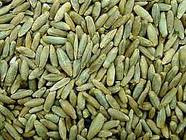Malt is produced from rye, by germinating the seed grain and roasting it; malt is then extracted from the grains. This is used as a sweetening agent and in brewing beer. In North America , rye is used as a base for whiskeys. The roasted grain can also be used as a substitute for coffee.
Like oats, rye comes in various forms, such as in flakes, when it looks like the oats used to make porridge, however the grain is also sold whole or cracked, and in the form of flour. Whole rye grains retain many of their nutrients because it is difficult to remove the rye germ and bran from the endosperm. The grain looks like wheat but can be longer and thinner, coming in shades of yellow-brown or grey-green. It is a member of the Poaceae family of plants which includes millet (bajra), oats, barley, sorghum and wheat as well as sugar cane and the grasses.
It was taken to the northeastern parts of what is now the USA
Like other whole grains it is full of nutrients, containing the B-complex vitamins, B1, B2, B3, B5 and B6 along with folate, vitamins A and E and the minerals calcium, iron, copper, manganese, magnesium, phosphorous (in which it is rich), potassium, selenium, sodium and zinc. It also has Omega-3 and -6 fatty acids and 18 amino acids along with flavonoids and phenolics which give it potent antioxidant properties, meaning that it can combat the free radicals that can damage cells and cause cancer. It has proven to be cardio protective as are other whole grains, and of benefit to post-menopausal women, who are advised to have six servings of whole grains per week in their diets to prevent high blood pressure and cholesterol levels and so protect the cardio-vascular system..

The long rye stalks have been used for thatching, paper-making, weaving small items such as mats and hats, used in mushroom compost and in the manufacture of tiles and bricks. In industry it is used as biomass and fuel. The root systems are long and can go deep into the soil so are good to stabilize sandy soils and prevent soil erosion.
Rye can grow up to 1.5 metres tall so a small person could hide in it, which is perhaps why J.D. Salinger chose to call his iconic novel “Catcher in the Rye” rather than in one of the other grass crops. Rye
 “Sing a song of sixpence a pocket full of rye,
“Sing a song of sixpence a pocket full of rye,Four and twenty blackbirds baked in a pie.
When the pie was opened the birds began to sing,
Oh wasn't that a dainty dish to set before the king?
The king was in his counting house counting out his money,
The queen was in the parlour eating bread and honey
The maid was in the garden hanging out the clothes,
When down came a blackbird and pecked off her nose!”
In this case rye was bought to feed the birds, and to lure them to the ground so that they could be caught and eaten, as they were considered a delicacy. Robert Burns, the Scots poet also wrote a poem whose chorus is “Coming thro’ the rye.” Rye Britain
You can substitute rye grains for rice, but soak overnight before cooking and when you drain the grains rinse again under cold running water. Cook like rice until tender. You can also use rye flakes instead of oats for porridge.
You can substitute rye grains for rice, but soak overnight before cooking and when you drain the grains rinse again under cold running water. Cook like rice until tender. You can also use rye flakes instead of oats for porridge.






















